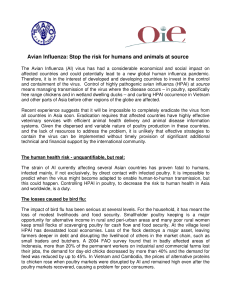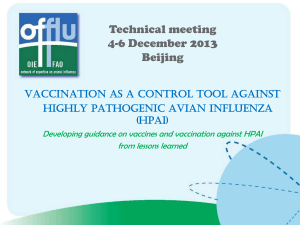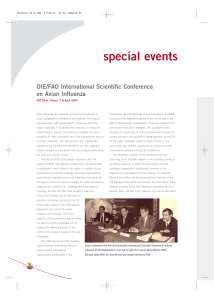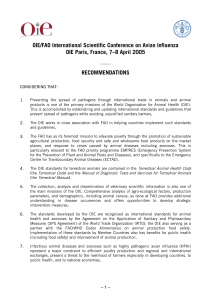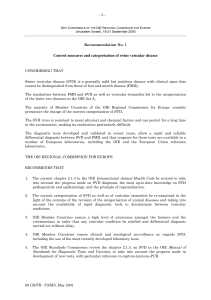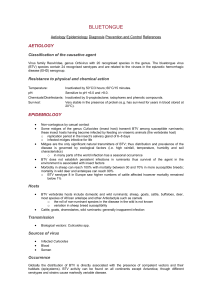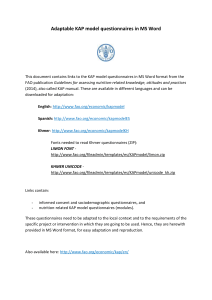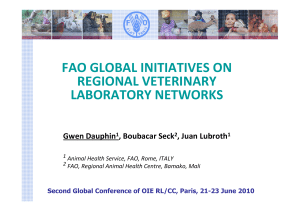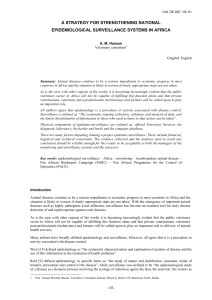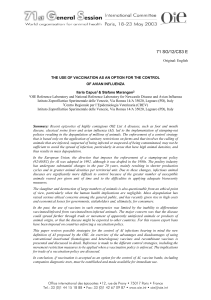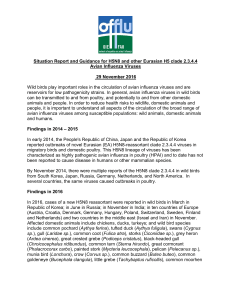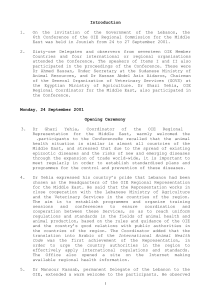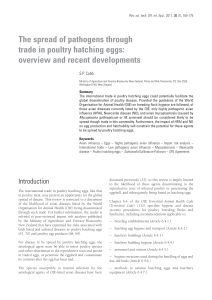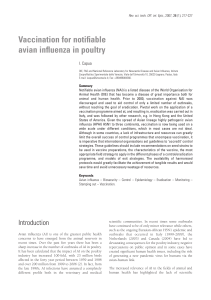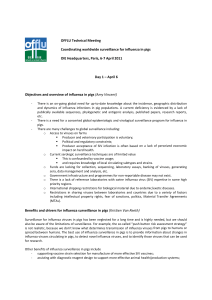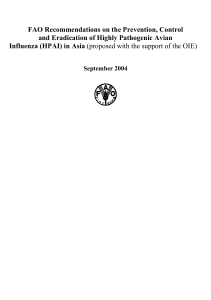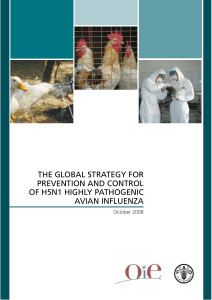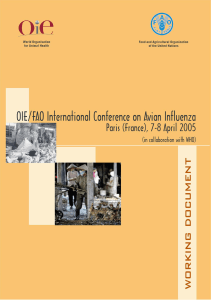D4418.PDF
publicité
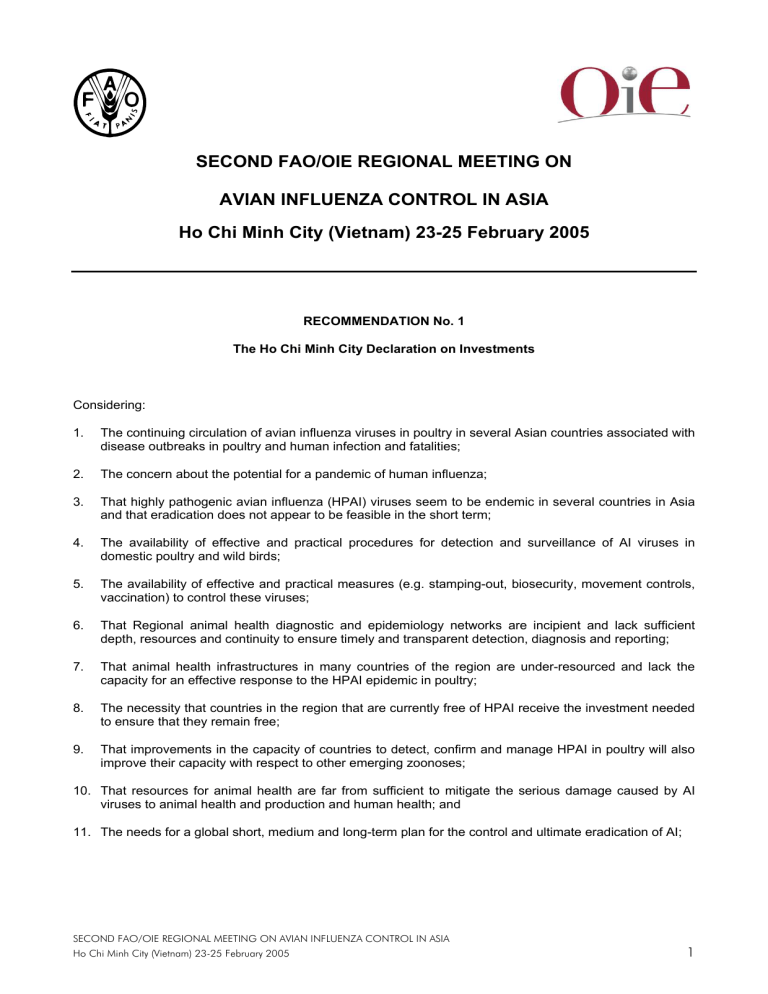
SECOND FAO/OIE REGIONAL MEETING ON AVIAN INFLUENZA CONTROL IN ASIA Ho Chi Minh City (Vietnam) 23-25 February 2005 RECOMMENDATION No. 1 The Ho Chi Minh City Declaration on Investments Considering: 1. The continuing circulation of avian influenza viruses in poultry in several Asian countries associated with disease outbreaks in poultry and human infection and fatalities; 2. The concern about the potential for a pandemic of human influenza; 3. That highly pathogenic avian influenza (HPAI) viruses seem to be endemic in several countries in Asia and that eradication does not appear to be feasible in the short term; 4. The availability of effective and practical procedures for detection and surveillance of AI viruses in domestic poultry and wild birds; 5. The availability of effective and practical measures (e.g. stamping-out, biosecurity, movement controls, vaccination) to control these viruses; 6. That Regional animal health diagnostic and epidemiology networks are incipient and lack sufficient depth, resources and continuity to ensure timely and transparent detection, diagnosis and reporting; 7. That animal health infrastructures in many countries of the region are under-resourced and lack the capacity for an effective response to the HPAI epidemic in poultry; 8. The necessity that countries in the region that are currently free of HPAI receive the investment needed to ensure that they remain free; 9. That improvements in the capacity of countries to detect, confirm and manage HPAI in poultry will also improve their capacity with respect to other emerging zoonoses; 10. That resources for animal health are far from sufficient to mitigate the serious damage caused by AI viruses to animal health and production and human health; and 11. The needs for a global short, medium and long-term plan for the control and ultimate eradication of AI; SECOND FAO/OIE REGIONAL MEETING ON AVIAN INFLUENZA CONTROL IN ASIA Ho Chi Minh City (Vietnam) 23-25 February 2005 1 The meeting recommends that: 1. Governments give increased priority and profile to build the capacity of animal and human health services and other necessary services to ensure they can exercise their responsibilities with respect to AI and other zoonoses; 2. A master coordination plan be prepared with a global vision defining the road map and time frames for the short, medium and long-term priority activities, to be endorsed and supported by individual countries and regional organisations; 3. Long-term, sustainable funding be sought to support key priorities identified in the outcome of this meeting; and 4. The investment required to support key priorities, identified during this meeting, for AI control in animals in countries currently infected and in countries that are currently free from the disease be in the order of: • international: $1 m p.y. (ongoing • regional: $3 m p.y. (ongoing) • national: $100 m (total) over a 3-5 year period. [noting that these estimates do not include the potentially significant costs associated with either compensation or major industry restructuring]. _______________ SECOND FAO/OIE REGIONAL MEETING ON AVIAN INFLUENZA CONTROL IN ASIA Ho Chi Minh City (Vietnam) 23-25 February 2005 2 RECOMMENDATION No. 2 International standards and surveillance for international trade Considering: 1. The importance and regional and international dimension of the AI crisis affecting animals and the potential public health implications; 2. The negative trade impacts that AI has had on international trade; 3. That the OIE has proposed new standards and guidelines on AI with respect to international trade, which will be proposed for adoption in May 2005 during the OIE General Session; 4. That the concept of compartmentalisation has already been agreed by the OIE International Committee, The meeting recommends that: 1. The OIE promulgate a policy paper explaining the specific requirements of implementation of compartmentalisation with respect to AI; 2. The OIE develop agreed methods of AI virus inactivation in processed products with respect to animal health, international trade and food safety issues; and 3. International (such as FAO/OIE) and Regional bodies (such as ASEAN and SAARC) continue to provide assistance to further strengthen countries’ compliance with international standards. _______________ SECOND FAO/OIE REGIONAL MEETING ON AVIAN INFLUENZA CONTROL IN ASIA Ho Chi Minh City (Vietnam) 23-25 February 2005 3 RECOMMENDATION No. 3 National/Regional/International co-ordination and co-operation Considering: 1. That AI is a transboundary disease which easily spreads between countries and has important regional and international dimensions; 2. That national control strategies should be harmonised and co-ordinated; 3. The mandates and missions of international and regional organizations; 4. The necessity to continue and sustain the regional networks that have been established as an emergency response to the AI crisis by the FAO and other bodies; The meeting recommends that: 1. The development of AI control and eradication regional plans in Asia be coordinated and monitored through ASEAN/ASEAN +3 and SAARC; 2. AI control and eradication national plans be developed (based on the regional coordinated plan) in a transparent manner and be well documented with a road map including time-frames; 3. Member countries build on the Southeast Asia Foot and Mouth Disease (SEAFMD) model to help strengthen regional co-operation and enhance national efforts to control and eradicate HPAI; 4. The international and regional organisations continue and further strengthen their activities in support of member countries; 5. The existing FAO regional networks for surveillance and diagnosis be sustained with additional support; 6. The FAO/OIE Global Framework for Transboundary Animal Diseases (GF-TADs) initiatives be used as a foundation for the regional approach to the control and eradicate AI. _______________ SECOND FAO/OIE REGIONAL MEETING ON AVIAN INFLUENZA CONTROL IN ASIA Ho Chi Minh City (Vietnam) 23-25 February 2005 4 RECOMMENDATION No. 4 Strategies for surveillance and control of avian influenza Considering: 1. The importance and the regional and international dimensions of the AI crisis affecting animals and the potential public health implications; 2. The necessity to stop the cycle of infection within identified reservoirs and prevent spill over into other susceptible animal species and man; 3. The need to prevent the spread of AI virus to unaffected countries; The meeting recommends that: 1. Countries plan control strategy based on scientifically designed risk analysis and surveillance surveys that identify reservoir species, agro-ecological areas and farming systems likely to maintain the infection; 2. The main risk infection pathways be mapped and appropriate and targeted surveillance strategies defined; 3. Disease be controlled at source through implementation of risk reduction interventions, including stamping-out, vaccination, improved biosecurity and education awareness. In AI free countries, vaccination would not normally be considered for the purpose of prevention; 4. Vaccination in poultry if applied in an appropriate manner can be used as an additional tool to protect human health and help towards the elimination of infection. However, vaccines should comply with OIE standards and vaccination strategies should be consistent with guidelines developed by FAO and supported by OIE; 5. That surveillance programmes be elaborated before vaccination is introduced. Likewise, an exit strategy has to be identified; 6. That Regional and International bodies provide assistance to countries in the region in capacity building; 7. That, wherever appropriate, diagnostic tests capable of differentiating infected from vaccinated (DIVA) birds be applied; 8. The efficacy of risk reduction and prevention procedures be monitored through targeted surveillance activities, including: • post vaccination surveillance to measure efficacy of vaccination, early identification of virus circulation, monitoring of genetic drift and emergence of new strains • monitoring reservoirs, including live bird markets • monitoring disease status of compartments or zones. _______________ SECOND FAO/OIE REGIONAL MEETING ON AVIAN INFLUENZA CONTROL IN ASIA Ho Chi Minh City (Vietnam) 23-25 February 2005 5 RECOMMENDATION No. 5 The implications of Highly Pathogenic Avian Influenza virus for human health Considering that: 1. The occurrence and spread of avian influenza caused by highly pathogenic avian influenza virus in the region are linked with traditional animal production including backyard and subsistence poultry production, multiple animal species farming practices as well as live poultry marketing systems; 2. Recent research has confirmed that aquatic birds, especially ducks can act as reservoir of infection with or without clinical signs and are capable of excreting large amounts of viruses in the environment; 3. It is likely that most human cases were acquired from direct contacts with sick or dead poultry; 4. Available scientific evidence does not indicate that H5N1 transmission represents an occupational risk in industrial slaughterhouses; 5. There is no risk to human health from consumption of wholesome and properly cooked, or processed products, including eggs provided that good hygienic practices are applied in food preparations; 6. The true risk of infection or disease in humans is not well understood; 7. Vaccination alone is unlikely to lead to a successful eradication but vaccination combined with stamping out and adequate surveillance will more likely lead to eradication in less time provided that vaccines used are produced in accordance with OIE standards; The meeting recommends that: 1. FAO, OIE and WHO develop guidelines for risk reduction along the whole length of the production and marketing chain for consideration at a joint technical consultation towards mid 2005. These guidelines should inter alia address: • identification of key risks especially for people working with animals, • development of feasible risk management strategies at the interface between humans and animals particularly in farming systems where biosecurity is minimal and at live animal markets, • the issue of appropriate education and awareness messages, and • the development of risk communication strategies taking account of local community risk perception; 2. HPAI suspect and clinically sick birds be humanely destroyed and disposed of along with dead poultry and not be allowed to enter the human food chain or be fed directly or indirectly to other animals including zoo animals; 3. Coordination of activities and financial resources between animal health authorities and those responsible for wildlife issues be encouraged for the early detection of possible animal and other zoonotic pathogens. _______________ SECOND FAO/OIE REGIONAL MEETING ON AVIAN INFLUENZA CONTROL IN ASIA Ho Chi Minh City (Vietnam) 23-25 February 2005 6 RECOMMENDATION No. 6 Research priorities for Avian Influenza Considering: 1. The importance and regional and international dimensions of the AI crisis affecting animal and public health; 2. That research and development are urgently needed to obtain better tools to prevent, control and ultimately eliminate AI; 3. That the past 12 months have provided veterinary services, international agencies and donors a deeper understanding of the research priorities; The meeting recommends that: 1. Specific research be conducted on AI surveillance and vaccination in ducks; 2. Further research be carried out under the aegis of OIE and FAO Reference Laboratories and private sector to develop diagnostic tests and vaccines to better address diagnostic and surveillance and control issues; 3. An expert consultation will be organised by FAO and OIE, in collaboration with WHO, to evaluate the results of research on new veterinary vaccines and their impact on risk reduction of disease in animals and humans; 4. Research be intensified on the role of wild and migratory birds in the epidemiology of AI; 5. Risk factors specific to each country be characterised to help refine disease control and eradication measures; 6. Research be carried out in small intensive farms and village poultry to better define risk management strategies, taking into account their economic viability and social acceptability; 7. Risk management strategies be identified for high risk bird populations such as fighting cocks, rare and endangered species; 8. A joint animal/public health/livelihoods risk assessment be conducted of the poultry supply chain that can be used for risk management and communication strategies; 9. Additional surveillance be carried out in people involved in handling poultry in HPAI infected countries; 10. Further studies be carried out on the survival time of the virus in the environment and environmentally sound disinfectants be developed to reduce the survival time of the virus in the environment and in material of high organic content; 11. Research be carried out on the economics of AI control and eradication, including the wider consequences of restructuring and the institutional requirements of financing long term AI prevention and control; 12. More sensitive, robust and inexpensive point of care (POC) tests for humans and animals be developed and validated; 13. A research agenda be defined building on the conclusions of this meeting as well as those of previous joint technical consultations of experts from OIE/FAO and WHO Reference Laboratories. _______________ SECOND FAO/OIE REGIONAL MEETING ON AVIAN INFLUENZA CONTROL IN ASIA Ho Chi Minh City (Vietnam) 23-25 February 2005 7 RECOMMENDATION No. 7 Economics and policy issues related to avian influenza Considering that 1. Although significant information is available to enable immediate decisions to be taken on AI surveillance and control, more information is required on the indirect costs of control measures, the implications of measures that may require restructuring of the poultry industry and the implications of AI and its control for the wider economy; 2. HPAI has potential zoonotic implications and broad impacts on the national economy, affecting sectors such as tourism making it a global issue that justifies international support; 3. AI control requires an efficient and transparent financing process with a clearly delineated framework for central and local funding; 4. A wide support system is needed that not only helps farmers to recover from immediate losses from outbreaks but also assists them in re-establishing their operations and improving animal husbandry practices with respect to animal health; 5. AI prevention and control measures can only be implemented through the establishment of effective and consistent operational plans based on supporting legislation; The meeting recommends that: 1. Financing the strengthening of veterinary services to improve capacity building to implement AI control activities be given the highest priority; 2. Analyses be made of the potential social and economic impacts of AI control measures. The result of these analyses will assist in defining funding needs and in national and regional planning. The outputs should be widely shared within countries and within the region; 3. Funding for AI can be expected to originate from a number of sources in the private and public sector. A substantial level of international investment can be justified; 4. The structure of animal health financing be reviewed; 5. Planning for AI control include a broad financial support system that also addresses elements of education and awareness programmes, credit accessibility including compensation and social relief programmes for the really poor; 6. Planners recognise the difficulty of designing equitable and efficient credit and compensation programmes and take advantage of the considerable experience that already exists within Asia and elsewhere; 7. Countries ensure that they all have comprehensive operational plans that incorporate local know-how, and ensure that all authorities fully understand them. _______________ SECOND FAO/OIE REGIONAL MEETING ON AVIAN INFLUENZA CONTROL IN ASIA Ho Chi Minh City (Vietnam) 23-25 February 2005 8
